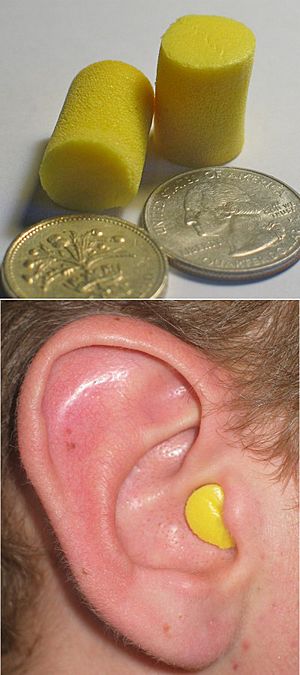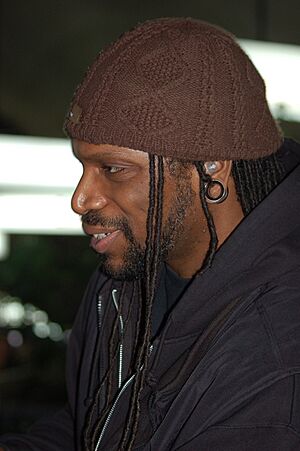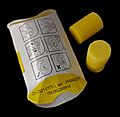Earplug facts for kids
An earplug is a small device you put inside your ear to protect it. Earplugs are mostly used to keep loud noises from hurting your hearing. They can also stop water, dust, or other things from getting into your ear canal.
Contents
What Are Earplugs Made Of?
Earplugs are made from different materials, each good for different uses.
- Wax earplugs - These are a bit firm. You usually need to warm them up and roll them with your fingers before putting them in your ears.
- Foam earplugs - Made from soft materials like polyvinyl chloride or polyurethane. You squeeze and roll them into a thin shape, then put them in your ear. Once inside, they slowly expand to fit your ear canal perfectly.
- Silicone earplugs - These are often softer than wax or foam. Instead of going deep inside your ear canal, they sit in the outer part of your ear.
- Flange earplugs - This name describes their special shape, not the material. They are flexible and have ridges or flaps, unlike the smooth earplugs mentioned above.
Some earplugs are made to be used once and thrown away (disposable), while others can be cleaned and used many times (reusable).
How Do Earplugs Help You?
Earplugs have many helpful uses, from protecting your hearing to helping you sleep.
Blocking Loud Sounds
The main reason people use earplugs is to protect their ears from loud sounds. They are great for places with constant noise, like concerts or busy restaurants. They can also block sudden loud sounds, like a siren passing by. Earplugs don't stop all sound, but they make loud noises much quieter and safer for your ears.
Earplugs for Sleeping
Some earplugs are extra soft and designed to stay in your ears comfortably while you sleep. They can block out noises like snoring or street sounds, helping you get a good night's rest.
Earplugs for Swimming
Special earplugs are made to keep water out of your ears. These are very useful for swimmers or anyone who spends a lot of time in the water. They help prevent problems like "surfer's ear", which is when cold water exposure causes extra bone growth in the ear canal.
Earplugs for Flying
For some people, changes in air pressure during airplane take-offs and landings can cause ear pain. There are earplugs designed to help balance the pressure in your ears, making flights more comfortable. They can also help you sleep by reducing the plane's noise.
Basic Earplugs for Work
Simple earplugs are often worn by workers who are around loud machines for a long time, like in factories. Soldiers also use them when firing weapons to protect their hearing. In many countries, earplugs are tested to show how well they reduce noise. This helps people choose the right earplugs for their needs.
Earplugs for Musicians
Musicians are often around very loud music, which can damage their hearing over time. Because of this, many musicians use special earplugs.
Musicians' earplugs are different because they reduce all sounds evenly, across all pitches. This means the music still sounds clear and balanced, just quieter. They often have tiny filters that lower the sound level without distorting the music. These earplugs are not for extremely loud noises (above 105 decibels).
There are different kinds:
- Universal earplugs are ready-made and fit most people.
- Custom earplugs are made just for your ears. An audiologist (an ear doctor) takes a mold of your ear, and then a company makes earplugs that fit perfectly. These often come with different filters, so musicians can choose how much sound they want to block (for example, 9, 15, or 25 decibels). Custom earplugs offer the best protection and sound quality.
Some musicians also use in-ear monitors. These are like earbuds that fit snugly in your ear. They play music directly to the musician but also block out surrounding sounds, acting like earplugs. However, if the music played through the monitors is too loud, it can still harm the musician's hearing.
Motorcyclists and skiers sometimes use special earplugs too, to reduce the constant noise of the wind against their head or helmet.
Electronic Earplugs
Most earplugs reduce all sounds equally. This means soft sounds become very hard to hear. Electronic earplugs are smarter. They have tiny microphones and speakers. They still block very loud noises to protect your hearing, but they can also let soft sounds through, or even make them a little louder. This means you can have a normal conversation when it's quiet, but still be protected if a sudden loud noise happens.
Images for kids
See also
 In Spanish: Tapón para los oídos para niños
In Spanish: Tapón para los oídos para niños









